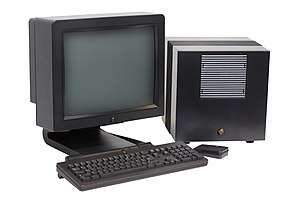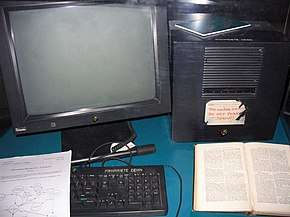NeXT Computer
NeXT Computer (also called the NeXT Computer System) is a workstation computer that was developed, marketed, and sold by NeXT Inc. It was introduced in October 1988 as the company's first and flagship product, at a price of US$6,500 (equivalent to $14,100 in 2019), aimed at the higher-education market. It was designed around the Motorola 68030 CPU and 68882 floating-point coprocessor, with a clock speed of 25 MHz. Its NeXTSTEP operating system is based on the Mach and BSD-derived Unix, with a proprietary GUI using a Display PostScript-based back end. The enclosure consists of a 1-foot (305 mm) die-cast magnesium cube-shaped black case, which led to the machine being informally referred to as "The Cube".
 NeXTcube with original monitor, keyboard and mouse | |
| Manufacturer | NeXT, Fremont, California |
|---|---|
| Type | Workstation |
| Release date | October 12, 1988 |
| Introductory price | US$6,500 (equivalent to $14,052 in 2019) |
| Discontinued | 1990 |
| Operating system | NeXTSTEP, OpenStep |
| CPU | Motorola 68030 @ 25 MHz, 68882 FPU @ 25 MHz, 56001 digital signal processor (DSP) @ 25 MHz |
| Memory | shipped with 8 MB, expandable to 64 MB using 4 MB Single Inline Memory Modules (SIMMs) |
| Storage | 256 MB magneto-optical drive, optional hard disk |
| Display | MegaPixel 17" monitor |
| Graphics | 1120×832 pixel resolution, four-level grayscale |
| Sound | built-in speakers |
| Input | 85-key keyboard, 2-button mouse |
| Connectivity | Ethernet |
| Power | 300 Watts, 3 Amperes |
| Dimensions | 1-foot (305 mm) die-cast magnesium cube-shaped case |
| Successor | NeXTcube |
The NeXT Computer was succeeded by the NeXTStation, an upgraded model in 1990.
Launch
The NeXT Computer was launched in October 1988 at a lavish invitation-only event, "NeXT Introduction – the Introduction to the NeXT Generation of Computers for Education" at the Louise M. Davies Symphony Hall in San Francisco, California. The next day, selected educators and software developers were invited to attend—for a $100 registration fee—the first public technical overview of the NeXT computer at an event called "The NeXT Day" at the San Francisco Hilton. It gave those interested in developing NeXT software an insight into the system's software architecture and object-oriented programming. Steve Jobs was the luncheon's speaker.
Reception
In 1989, BYTE magazine listed the NeXT Computer among the "Excellence" winners of the BYTE Awards, stating that it showed "what can be done when a personal computer is designed as a system, and not a collection of hardware elements". Citing as "truly innovative" the optical drive, DSP and object-oriented programming environment, it concluded that "the NeXT Computer is worth every penny of its $6,500 market price".[1] It was, however, not a significant commercial success, failing to reach the level of high-volume sales like the Apple II, Commodore 64, Macintosh, or Microsoft Windows PCs. The workstations were sold to universities, financial institutions, and government agencies.[2]
Legacy

A NeXT Computer and its object-oriented development tools and libraries were used by Tim Berners-Lee and Robert Cailliau at CERN to develop the world's first web server (CERN httpd) and web browser (WorldWideWeb).
The NeXT platform was used by Jesse Tayler at Paget Press to develop the first electronic app store, the Electronic AppWrapper in the early 1990s. Issue #3 was first demonstrated to Steve Jobs at NeXTWorld Expo 1993.
Pioneering PC games Doom, Doom II, and Quake (with respective level editors) were developed by id Software on NeXT machines. Doom engine games such as Heretic, Hexen, and Strife were also developed on NeXT hardware using id's tools.[3]
NeXT technology provisioned the first online food delivery system called CyberSlice, using GIS based geolocation, on which Steve Jobs performed the first online order of pizza with tomato and basil. CyberSlice was curated into the Inventions of the 20th Century, Computer Science[4] at the Smithsonian Institution in Washington DC.[5][6]
See also
- Previous, emulator of NeXT hardware
- NeXTstation
- NeXTcube
- NeXTcube Turbo
- NeXT character set
References
- "The BYTE Awards". BYTE. January 1989. p. 327.
- "NeXT Computer | Science Museum Group Collection". collection.sciencemuseumgroup.org.uk. Retrieved 2020-01-27.
- "Apple-NeXT Merger Birthday!". Archived from the original on March 5, 2007.
- "CyberSlice, Incorporated". Smithsonian Institution. Smithsonian Institution.
- "AppStorey talks with Steve Green about Steve Jobs, The Smithsonian and how a pizza with basil became the first food delivered via the web". AppStorey. June 6, 2019. Retrieved June 7, 2019.
- PMQ Pizza Magazine (June 3, 2019), How Steve Jobs Made Pizza History, retrieved June 7, 2019
External links
| Wikimedia Commons has media related to NeXT. |
- Byte Magazine, November 1988: The NeXT Computer Facsimile, Full text
- Simson Garfinkel's NeXT pages including NeXTWorld Magazine
- The Best of NeXT Collection
- NeXT Computer brochure (page 7 contains a full size image of the circuit board)
- old-computers.com — NeXTcube
- Photos of black hardware